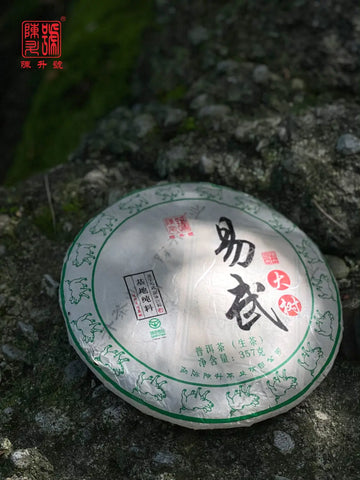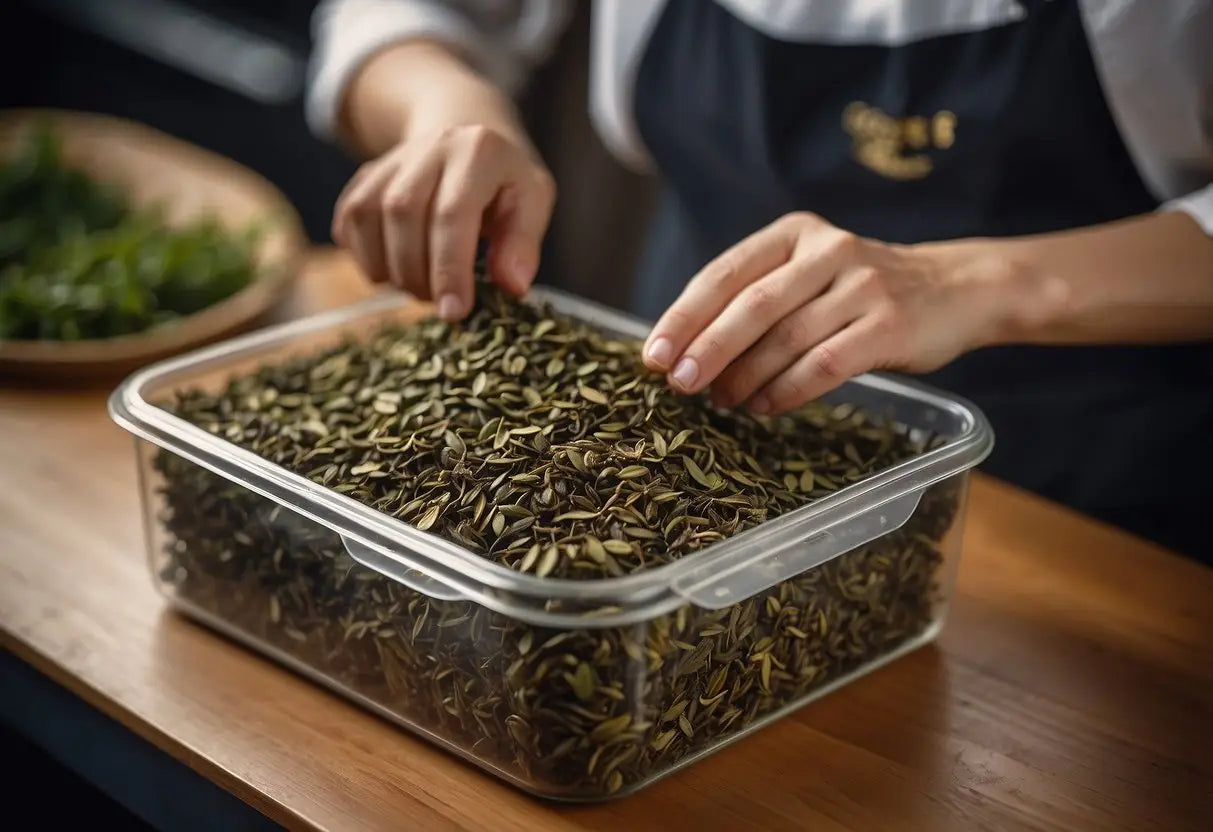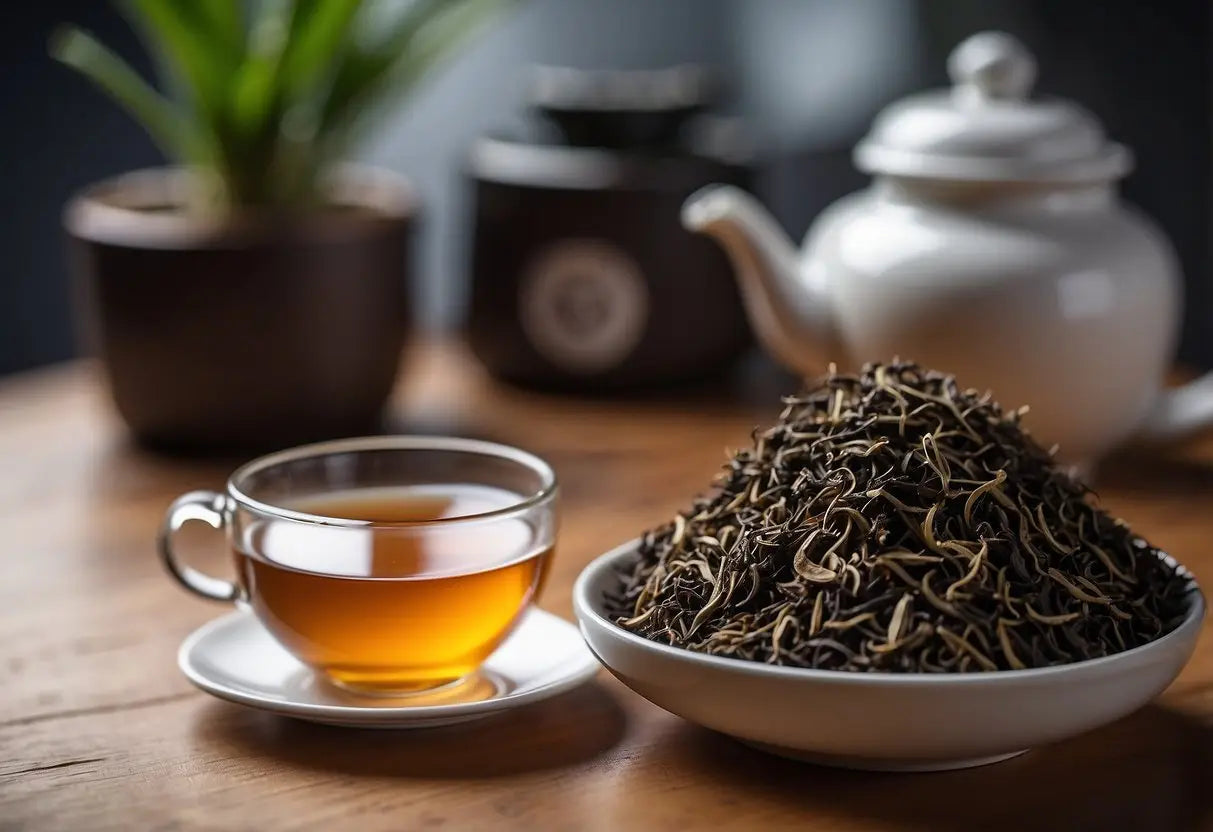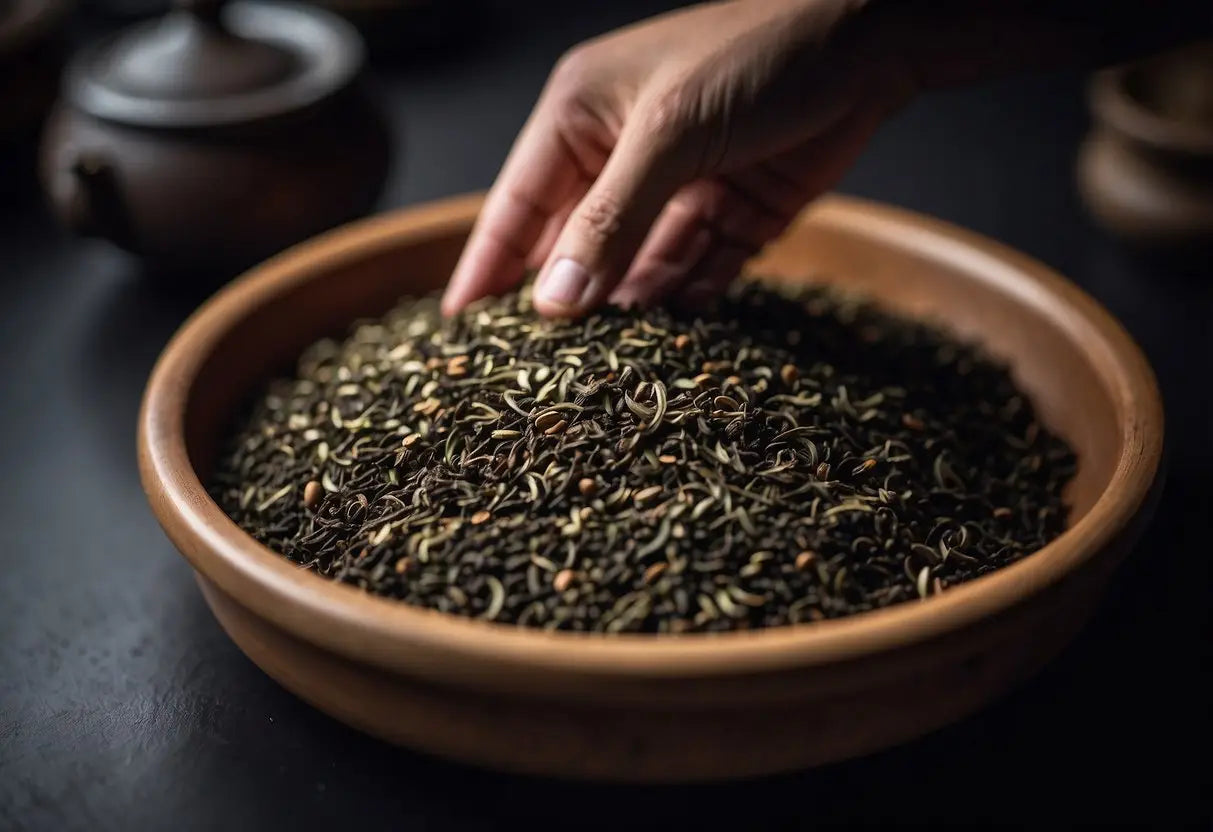How to Store Pu Erh Tea
Pu-erh tea, known for its unique aging process and rich history, is a distinctive type of fermented tea with deep cultural roots. It's important to grasp its origins, types, and key characteristics to truly appreciate this special beverage.
History and Origin
Pu-erh tea originates from Yunnan Province, China. It dates back to the Tang Dynasty (618-907 AD), where it was originally traded along ancient tea routes. This tea was named after the Pu-erh region, which became a central trading hub.
The traditional method of processing involves raw (sheng) and ripened (shou) varieties. Sheng Pu-erh is naturally fermented over years, while shou Pu-erh undergoes an accelerated fermentation. This history contributes to Pu-erh’s unique characteristics and cultural significance.
Bestsellers
Types of Pu-erh Tea
Pu-erh tea is divided into two main categories: Sheng (raw) and Shou (cooked or ripened). Sheng Pu-erh is aged for several years, developing complex flavors over time. Shou Pu-erh undergoes a process where the leaves are piled, moistened, and covered to speed up fermentation, creating a darker, richer tea.
Both types come in various forms, including loose leaf and compressed cakes. The aging process can last anywhere from a few months to many decades, with each batch offering a unique taste profile.
| Type | Description |
|---|---|
| Sheng | Naturally aged, lighter, complex flavor |
| Shou | Artificially fermented, darker, richer taste |
Characteristics of Pu-erh Tea
Pu-erh tea is known for its earthy, woody flavors and smooth texture. As it ages, the tea develops deeper, more intricate tastes. The aroma can range from floral to mushroom-like, depending on the length and conditions of aging.
A key characteristic is its health benefits. Pu-erh is believed to aid in digestion, lower cholesterol, and improve metabolism. It also contains lower caffeine levels compared to other teas, making it a popular choice for those seeking a milder stimulant.
Recognizing the specific traits of Pu-erh can enhance your enjoyment and selection of this unique tea.
Optimal Storage Conditions

To preserve pu erh tea’s unique flavor and longevity, you must regulate temperature, humidity, light exposure, and air flow.
Temperature Control
Store pu erh tea at a stable temperature. Extreme fluctuations harm the tea leaves, impacting flavor and aging process. Aim for a consistent temperature between 68°F and 77°F (20°C to 25°C). Avoid storing tea in the kitchen or near heat sources like ovens and stoves. Excessive heat accelerates oxidation, spoiling the integrity of the tea. Conversely, cold environments hinder proper aging, leading to a flat taste.
Humidity Management
Humidity plays a crucial role in pu erh tea storage. Optimal humidity levels should be around 60-70%. Use a hygrometer to monitor the environment. Too much moisture leads to mold growth, while dry conditions prevent proper aging. If necessary, use a humidifier or dehumidifier to maintain appropriate levels. Avoid areas prone to dampness, such as basements, and ensure your storage space has natural airflow.
Light Exposure
Direct sunlight degrades pu erh tea, damaging its delicate components. Store tea in dark, opaque containers to shield it from light. Cabinets and drawers away from windows are ideal storage locations. Transparent jars and clear bags should be avoided, as they allow light to penetrate and affect the tea quality negatively. Consider using ceramic or tin containers with tight fittings for best results.
Air Flow Considerations
Proper air circulation is vital. Stale air can lead to a musty aroma, while excessive ventilation can cause dryness. Use breathable materials like cotton pouches or paper wrappings. Avoid vacuum-sealed containers which restrict air flow too much. Place tea in well-ventilated areas to facilitate mild air exchange but avoid areas with strong odors, which pu erh can absorb, altering its flavor profile.
Choosing Storage Containers
Selecting the right containers for storing Pu'erh tea is critical to preserving its unique flavor and ensuring proper aging. Focus on material suitability, container size and shape, and sealing and airtightness.
Lao Ban Zhang
Material Suitability
The material of the storage container impacts the tea's aging process. Porous materials like clay or ceramic are highly recommended as they allow air circulation while protecting the tea from external odors. Glass containers are acceptable if placed in a dark environment to avoid light exposure.
Metal containers should be avoided since they can impart unwanted flavors. Plastic containers may also absorb and release odors, negatively affecting the tea. Ensure the material is food-grade and free of harmful chemicals to maintain the tea’s purity.
Container Size and Shape
The size and shape of the container play a significant role. Large containers are ideal for holding entire tea cakes or multiple loose leaves together. This helps retain the tea's natural aging process. Using a container too small may crush the leaves and damage their structure.
Round or oval-shaped containers work best as they minimize sharp corners where leaves can be trapped and broken. Make sure the container fits comfortably in your storage area, allowing for easy access and proper airflow.
Sealing and Airtightness
Proper sealing is crucial to protect Pu'erh tea from moisture, pests, and foreign odors. Some air circulation is beneficial for aging, so opt for containers with a loose-fitting lid for short-term storage. For long-term storage, however, a moderate seal helps maintain the tea’s integrity without making it completely airtight.
Avoid using containers with tight rubber seals or vacuum sealing, as this could hinder the aging process by completely cutting off air circulation. Instead, use containers that balance between being secure and allowing minimal airflow.
Preparing Tea for Storage
Proper preparation of Pu Erh tea before storage ensures its longevity and maintains its unique flavor. This includes meticulously cleaning and prepping storage containers, and carefully inspecting and handling the tea.

Cleaning and Prepping Containers
Select an airtight container to protect tea from moisture, odors, and light. For cleaning, use warm water and a mild, scent-free detergent. Thoroughly rinse to remove any soap residue. Dry the container completely before use.
Avoid using metal containers, as they can adversely affect the taste. Porcelain or thick, food-grade plastic containers can be ideal. Ensure the container is free from any residual scents from previous contents.
Tea Inspection and Handling
Check each piece of Pu Erh for mold or any irregularities. Moldy tea must be discarded, as it can spoil the rest of your batch.
Handle tea with clean, dry hands or use food-grade gloves to avoid introducing oils or contaminants. Break tea cakes or bricks into manageable pieces for even storage. Use a soft, dry brush to remove any loose debris before sealing for storage.
Long-term vs. Short-term Storage
When storing Pu Erh tea, it's essential to consider whether you plan on short-term or long-term storage.
Short-term storage typically involves consuming the tea within a year or two. Long-term storage involves keeping the tea for several years or even decades.
Environment
For short-term storage, keep Pu Erh tea in a cool, dry place, away from direct sunlight and strong odors. A kitchen cupboard or pantry usually works well.
Long-term storage requires more attention. You need to maintain stable conditions. A dry, well-ventilated area with stable temperatures is vital. Humidity should be controlled, ideally between 60-70%.
Containers
For short-term storage, airtight containers are acceptable. Materials like porcelain, clay, or food-grade plastic will do.
For long-term storage, clay or ceramic containers are preferred. These materials allow the tea to breathe, which is crucial for aging.
Airflow
Short-term storage doesn't require special airflow considerations. Just ensure the location is not too humid.
For long-term storage, proper airflow is essential. The area should be well-ventilated to prevent mold growth. Avoid closed, airtight locations for long durations.
Monitoring
In short-term storage, periodic checks every few months are sufficient. Simply ensure no signs of moisture or odors.
For long-term storage, more rigorous monitoring is required. Check conditions every few weeks, ensuring stable humidity and temperature.
Benefits
Short-term storage keeps your tea fresh and ready to use. Long-term storage enhances the aging process, developing the tea's flavor complexity.
Keeping these factors in mind will help you choose the right storage method for your Pu Erh tea.
Monitoring and Adjusting Storage Conditions

Regularly check the humidity levels in your storage area. Optimal humidity for Pu-erh tea is between 60% and 70%. Use a hygrometer to monitor this.
If humidity levels drop, use a small bowl of water to increase it. If it rises too much, add silica gel packets to absorb moisture.
Temperature is another crucial factor. Ideal temperature ranges from 20°C to 30°C. Sudden changes in temperature can spoil the tea.
Monitor for any signs of mold or unwanted odors. These can indicate poor storage conditions and need immediate attention.
Ensure your storage area is well-ventilated. Stale air can affect the aging process negatively. You can use small fans to improve air circulation.
Check the storage containers regularly. Make sure they are airtight yet breathable. This balance is key for proper aging and flavor development.
Adjust storage conditions according to seasonal changes. Use a dehumidifier in the rainy season and a humidifier during dry months to maintain optimal conditions.
Common Storage Mistakes to Avoid

Avoid storing your Pu-erh tea in direct sunlight. Sunlight can cause the tea to age unevenly and lose its flavor.
Do not store Pu-erh tea in high humidity or damp areas. Excess moisture can cause mold growth and ruin the tea leaves.
Packaging matters. Avoid plastic bags as they can trap moisture. Instead, use breathable materials like paper or cloth.
Temperature control is key. Keep the tea in a cool, stable environment. Fluctuating temperatures can negatively impact the aging process.
Do not store Pu-erh tea near strong odors, such as spices or cleaning products. The tea can absorb these smells, affecting its taste.
Never compress your tea tightly. Allow some air circulation to promote proper aging. Overly compacted tea can develop off flavors.
Regularly inspect your tea. Look for any signs of mold or pests. Early detection can save the rest of your stash.
Labeling is important. Always note the purchase date and type of tea on the storage container. This helps you keep track of your tea's age and better manage your inventory.
Ensure your storage area is clean. A dusty or dirty environment can introduce unwanted particles to the tea.
By avoiding these common mistakes, you can ensure your Pu-erh tea remains in optimal condition for years to come.
Refreshing Stored Pu-erh Tea

Over time, pu-erh tea might lose some of its vibrancy. To refresh it, start by examining the tea for any signs of mold or unpleasant odors. If it looks healthy, you’re ready to proceed.
Steps to Refresh Pu-erh Tea:
1. Air It Out: Spread the tea leaves on a clean surface. Leave them in a well-ventilated area for a few hours. Fresh air helps dissipate any stale smells.2. Rinse Before Brewing: Use warm water to rinse the tea leaves. This can help remove any dust or impurities that may have settled during storage.
3. Adjust Brewing Time: You might need to experiment with brewing times. Start with shorter steeping periods to see how the flavors develop.
Tools and Tips
| Tool | Purpose |
|---|---|
| Clean Surface | For airing out the tea leaves |
| Warm Water | To rinse the leaves before brewing |
| Tea Set | Adjust brewing time to find the best flavor |
Important Tips:
- Store in a dry, odor-free environment.
- Avoid direct sunlight during the airing process.
Refreshing stored pu-erh tea can bring out its rich, nuanced flavors once again. Enjoy the renewed experience of your cherished tea.
← Older post Newer post →











